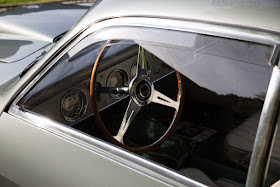As early as 1945, Fiat was working on a eight-cylinder engine. The idea was a new engine for mass production but that never happened so instead a limited series of sports cars were produced. Released at the 1952 Geneva Auto Show with factory-designed bodywork by Rapi, the 8V was touted as a competition car and many of the very first 8Vs were also prepared for racing and sold to racing clientele. With a fully independent suspension from the Fiat 1100 and 124 mph top speed, it was competitive in the two-liter classes, winning the Italian GT Championship in 1954.
The 1996cc Ottu Vù engine was designed by Dante Giacosa in aluminum alloy. Its short stroke was suitable for high-revs and a steep power curve. The 8V engine wasn’t used in any other Fiat model, but because of its narrow dimensions several other companies adopted the design including Siata for their 208S.
The V8’s standard specification produced 105bhp at 5,600rpm and Fiat offered a factory option with twin Weber carburetors producing 115bhp. Some engines were fitted with huge four-throat Weber 36 IF4/C carburetors offering 120 bhp. The engine was fit into a standard steel tube chassis with Fiat 1100 suspension components.
Just enough 8Vs were made over to meet international homologation regulations. Fiat also outsourced many 8V bodies to the Italian design houses including Zagato (32), Ghia (14 Supersonics and 1 Coupe), Vignale (10) and Pininfarina (1). No two cars are alike and each has a unique style.
Zagato bought 32 chassis in a joint venture with Franco Cornacchia. Four of which already had partial bodywork installed by Fiat. These were modified with aluminum double-bubble top and modified windows appended to the face-lifted steel lower bodywork. These Coupes were called 'Elaboratas'. One chassis was used to build a Spyder. The remaining 27 chassis were fitted with all new lightweight alloy Zagato bodies. This small Coupe was simply called 8VZ. Only five of these Coupes feature the famous double-bubble roof. As each car was hand-built to customer order until 1959, each Zagato-bodied 8V Berlinetta was unique, representing a bespoke automobile with subtle variations noted from one car to another. (supercars.net & coachbuild.com)
Zagato bought 32 chassis in a joint venture with Franco Cornacchia. Four of which already had partial bodywork installed by Fiat. These were modified with aluminum double-bubble top and modified windows appended to the face-lifted steel lower bodywork. These Coupes were called 'Elaboratas'. One chassis was used to build a Spyder. The remaining 27 chassis were fitted with all new lightweight alloy Zagato bodies. This small Coupe was simply called 8VZ. Only five of these Coupes feature the famous double-bubble roof. As each car was hand-built to customer order until 1959, each Zagato-bodied 8V Berlinetta was unique, representing a bespoke automobile with subtle variations noted from one car to another. (supercars.net & coachbuild.com)
Chassis 106*000002
Chassis 106*000026
Chassis 106*000063
Chassis 106*000076
Chassis 106*000082
Chassis 106*000084
Chassis 106*000108
(Photos from supercars.net, ultimatecarpage.com, coachbuild.com,
girlsdrivefasttoo.com and dragoneauctions.com)













































































































